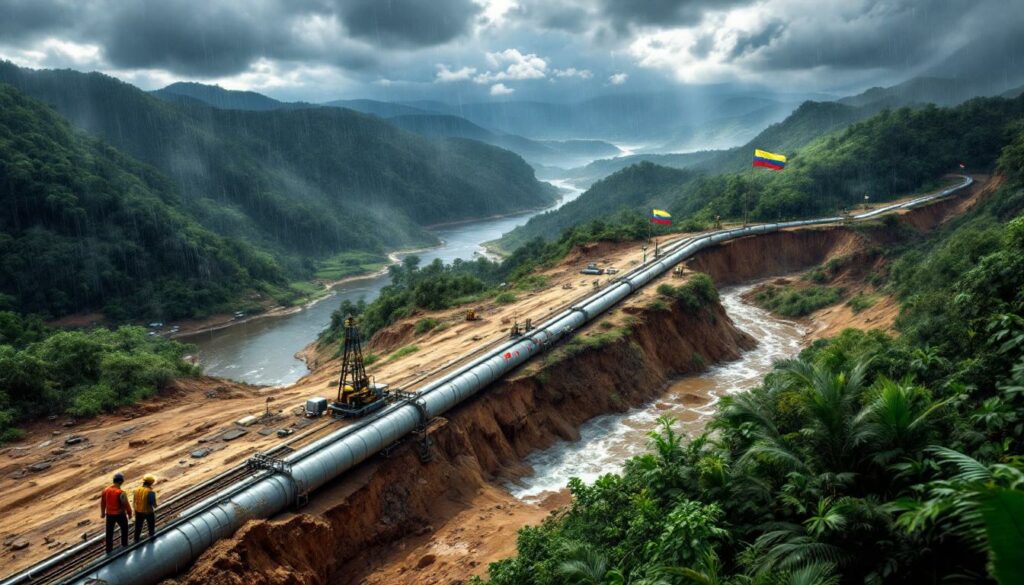Why Have Ecuador's Oil Pipelines Shut Down?
Ecuador is facing a severe oil production crisis, with output plummeting to historic lows due to pipeline shutdowns. The situation, which began on July 2, 2025, has escalated into a national economic emergency as the country's vital oil transportation infrastructure has been compromised by environmental factors.
Environmental Factors Triggering the Crisis
Heavy rainfall across Ecuador has triggered extensive erosion along the Coca River, creating hazardous conditions for the country's vital oil infrastructure. This erosion, which began in 2020, has progressively worsened over the past five years, damaging roads and threatening pipeline integrity throughout the Napo province.
"The ongoing heavy rains have intensified erosion in the Napo province, particularly along the Coca River, where both pipelines run in proximity for a stretch," explains Udayan Anand, Analyst at Rystad Energy's Upstream Research division.
The geographical challenges faced by Ecuador's oil transportation system create inherent vulnerabilities, as pipeline routes follow river valleys through mountainous terrain. With both major pipelines running parallel along the Coca River for critical stretches, when environmental conditions deteriorate, the entire oil transportation system becomes compromised simultaneously.
Critical Infrastructure Affected
Two major pipelines have ceased operations due to these environmental challenges:
- Sistema de Oleoducto Transecuatoriano (SOTE): Shut down on July 2, 2025, with a capacity of 360,000 barrels per day
- Oleoducto de Crudos Pesados (OCP): Operations suspended due to erosion risks, with a capacity of 450,000 barrels per day
These pipelines are specially designed to handle Ecuador's medium to heavy sour crude and together transported an average of 460,000 barrels per day between January and May 2025. Prior to the shutdown, SOTE accounted for 57% of total oil transport, while OCP handled the remaining 43%.
How Severe is the Production Decline?
The impact of the pipeline shutdowns on Ecuador's oil production has been catastrophic, with output falling to levels not seen in decades.
Current Production Statistics
The pipeline shutdowns have triggered an unprecedented decline in Ecuador's oil output:
- Pre-crisis production (June 2025): 464,000 barrels per day
- Current production from EP Petroecuador fields: Approximately 38,500 barrels per day
- Decline percentage: Nearly 90% reduction from EP Petroecuador's operated fields
"This level marks the lowest output recorded in the company's history," notes Udayan Anand from Rystad Energy, highlighting the severity of the situation.
Pipeline Throughput Collapse
The throughput statistics reveal the severity of the operational disruption:
- SOTE pipeline: Operating at just 10% of normal capacity (23,300 bpd vs. normal 230,000 bpd)
- OCP pipeline: Functioning at merely 2% of standard throughput (3,500 bpd vs. normal 175,000 bpd)
These figures demonstrate the near-complete shutdown of Ecuador's oil transportation capacity, with both pipelines operating at a tiny fraction of their designed throughput.
Major Fields Affected
The crisis has completely halted production at Ecuador's most productive oil blocks:
- Block 61 (Auca): No production since July 8
- Block 60 (Sacha): Zero output from Ecuador's largest producing field (normally 75,000 bpd)
- Block 43 (ITT): Significant disruption to operations
These three major blocks alone contributed 42% of Ecuador's total oil output in June 2025, highlighting how the shutdown has impacted the country's most productive assets. The active well count has plummeted from 2,500 to just 523 wells—a staggering 79% reduction in operational capacity.
What Are the Economic Consequences for Ecuador?
The economic ramifications of this production collapse extend far beyond the oil sector, threatening Ecuador's overall economic stability.
Oil's Importance to Ecuador's Economy
Oil represents a cornerstone of Ecuador's economic foundation:
- Contributes 6-8% of the country's GDP
- Generated approximately $13 billion in revenue during 2024
- Provides a substantial portion of government funding and export earnings
As Udayan Anand explains, "Oil plays a critical role in Ecuador's economy, contributing between 6% and 8% of gross domestic product (GDP) in recent years, and accounting for a significant portion of government revenues and export earnings."
The national oil company, EP Petroecuador, accounts for approximately 80% of the country's total oil production, with private operators responsible for the remaining 20%. This means the government bears the brunt of the financial impact from production disruptions.
Financial Impact Assessment
The current crisis is creating severe financial strain:
- Revenue already projected to decline by 15% in 2025 (to $11 billion) due to aging fields and lower oil prices
- Additional estimated revenue loss from current disruption: $300 million
- Well operations: Only 523 of 2,500 wells remain active (79% reduction)
These losses come at a particularly challenging time for Ecuador, as the country was already anticipating reduced oil revenues in 2025 due to natural field decline and lower global oil prices. The pipeline crisis has exacerbated these financial challenges, creating an urgent need for economic mitigation strategies.
How Did Force Majeure Impact Operations?
The declaration of force majeure marked a critical turning point in Ecuador's response to the growing crisis.
Emergency Measures Implementation
On July 2, 2025, EP Petroecuador declared force majeure on pipeline operations to:
- Protect remaining infrastructure from further damage
- Mitigate potential environmental impacts from pipeline failures
- Establish legal protection for contractual obligations during the crisis
This legal declaration acknowledged that circumstances beyond EP Petroecuador's control prevented the company from fulfilling its contractual obligations to transport and deliver oil. Force majeure provides temporary legal protection from penalties that would normally apply for contract non-performance.
Operational Response Strategy
The emergency declaration triggered:
- Immediate shutdown of the SOTE pipeline
- Suspension of operations along the OCP pipeline
- Cessation of production activities across major oil blocks
- Emergency assessment of infrastructure vulnerability along erosion-affected areas
While these measures were necessary to prevent potential pipeline ruptures and oil spills, they resulted in the dramatic production decline that continues to impact Ecuador's oil sector and broader economy.
What Makes Ecuador's Oil Infrastructure Vulnerable?
The current crisis has highlighted structural vulnerabilities in Ecuador's oil transportation system that make it particularly susceptible to environmental disruptions.
Geographic Challenges
Ecuador's oil transportation system faces inherent vulnerabilities:
- Pipeline routes follow river valleys through mountainous terrain
- Both major pipelines run parallel along the Coca River for critical stretches
- Regions prone to heavy seasonal rainfall and subsequent erosion
- Limited alternative routing options due to topographical constraints
The concentration of pipeline infrastructure along river valleys maximizes efficiency under normal conditions but creates a single point of failure during environmental emergencies. When erosion threatens one pipeline, it typically threatens both, as demonstrated by the current crisis.
Infrastructure Limitations
The country's oil infrastructure exhibits several weaknesses:
- Aging pipeline systems with limited redundancy
- Concentration of transportation capacity in just two major pipelines
- Heavy dependence on medium to heavy sour crude varieties that require specialized handling
- Limited storage capacity to buffer production during transportation disruptions
These structural limitations amplify the impact of environmental disruptions, as Ecuador lacks the redundant infrastructure and storage capacity that might allow for continued production during pipeline outages.
How Will This Crisis Affect Global Oil Markets?
While devastating for Ecuador, the crisis has had limited impact on global oil markets due to the relatively small share of worldwide production affected.
Supply Impact Assessment
While significant for Ecuador, the global impact remains limited:
- Ecuador's total production represents less than 0.5% of global oil supply
- Regional markets may experience some supply tightening
- Limited effect on global oil price movements expected unless disruption extends for months
The global oil market has sufficient flexibility to absorb the loss of Ecuador's production without significant price disruptions. However, regional markets, particularly those that typically receive Ecuador's crude exports, may experience more noticeable supply adjustments.
Market Response Indicators
Early market reactions suggest:
- Minimal price movement in international benchmark crude prices
- Some adjustment in regional refined product pricing
- Potential opportunity for neighboring producers to fill supply gaps
For global oil traders, the Ecuador situation represents a regional supply disruption rather than a market-moving event. Nevertheless, the situation bears monitoring, particularly if the disruption extends beyond initial recovery estimates.
What Are the Long-Term Implications for Ecuador?
Beyond the immediate crisis, Ecuador faces significant long-term challenges related to infrastructure resilience and economic diversification.
Economic Recovery Challenges
The crisis highlights several long-term concerns:
- Increased fiscal pressure on an already strained national budget
- Potential delays in planned infrastructure investments
- Heightened investor uncertainty about Ecuador's oil sector reliability
- Possible credit rating implications if disruption extends
With oil accounting for 6-8% of GDP and a significant portion of government revenue, prolonged production disruption could trigger broader economic impacts, including challenges meeting fiscal obligations and maintaining essential government services.
Infrastructure Resilience Requirements
This event underscores the need for:
- Comprehensive pipeline route assessment and potential rerouting in vulnerable areas
- Enhanced erosion monitoring and early warning systems
- Increased infrastructure redundancy and contingency planning
- Accelerated diversification of Ecuador's economy beyond oil dependency
The current crisis demonstrates that Ecuador's oil infrastructure requires significant investment in resilience measures to withstand environmental challenges. Additionally, the country's heavy economic dependence on oil creates vulnerability to production disruptions, highlighting the importance of economic diversification.
How Does This Compare to Previous Disruptions?
While Ecuador has experienced pipeline disruptions before, the current crisis stands out for its severity and comprehensive impact on the country's oil infrastructure.
Historical Context
Ecuador has experienced pipeline disruptions before, but this event stands out:
- Current production levels represent the lowest output in EP Petroecuador's history
- The scale of well shutdowns (79% of producing wells) is unprecedented
- Previous disruptions typically affected single pipeline systems rather than both major routes
- Recovery timelines from past events suggest weeks or months may be required to restore full operations
The simultaneous shutdown of both major pipelines distinguishes this event from previous disruptions, which typically affected only one transportation system. This comprehensive infrastructure failure explains the unprecedented production decline.
Lessons from Past Crises
Previous disruptions have demonstrated:
- The importance of rapid engineering responses to erosion threats
- Benefits of maintaining emergency production storage capacity
- Value of diversified export routes and transportation options
- Need for coordinated emergency response between public and private operators
Historical pipeline disruptions in Ecuador have typically been resolved within weeks to months, depending on the severity of damage and environmental conditions. However, the current crisis affects both major pipelines simultaneously, potentially extending the recovery timeline.
What Steps Are Being Taken to Restore Production?
Ecuador is implementing a multifaceted approach to address the immediate crisis while developing longer-term solutions to prevent future disruptions.
Emergency Response Measures
Authorities and operators are implementing several strategies:
- Engineering assessments of pipeline integrity in affected areas
- Temporary stabilization measures along vulnerable river sections
- Prioritization of production from fields with alternative transportation options
- Coordination between government agencies and private operators to maximize available infrastructure
The immediate focus is on assessing pipeline integrity and implementing temporary stabilization measures to allow safe resumption of operations. Simultaneously, authorities are working to maximize production from fields that can utilize the limited transportation capacity still available.
Recovery Timeline Projections
Based on the severity of the disruption:
- Initial pipeline repairs may take 2-4 weeks under optimal conditions
- Full production restoration could require 1-3 months
- Complete infrastructure remediation and erosion control may extend 6-12 months
- Long-term solutions may necessitate significant pipeline rerouting
Recovery efforts face significant challenges, including ongoing environmental conditions, the extensive nature of erosion damage, and the complexity of pipeline infrastructure. While temporary repairs may allow partial resumption of operations within weeks, full restoration of production capacity will likely require months of concentrated effort.
FAQ: Ecuador's Oil Production Crisis
How much oil does Ecuador typically produce?
Ecuador normally produces approximately 464,000 barrels per day, with about 80% coming from fields operated by the national oil company EP Petroecuador and the remainder from private operators. This production level makes Ecuador a relatively small producer on the global stage but represents a crucial component of the country's economy.
What percentage of Ecuador's economy depends on oil?
Oil contributes between 6-8% of Ecuador's GDP and represents a significant portion of government revenue and export earnings, making it a critical sector for the country's economic stability. The $13 billion in revenue generated in 2024 underscores the sector's importance to government finances.
How long might the production disruption last?
While official timelines haven't been announced, similar infrastructure disruptions typically require weeks to months for full restoration, depending on the severity of environmental damage and complexity of repairs needed. Initial pipeline repairs may take 2-4 weeks under optimal conditions, but full production restoration could require 1-3 months or longer.
Will this crisis affect global oil prices?
The global impact is expected to be minimal as Ecuador's production represents less than 0.5% of worldwide supply, though regional markets may experience some temporary adjustments. Global oil markets have sufficient flexibility to absorb this supply disruption without significant oil price crash analysis showing minimal impact from Ecuador's situation.
What are the environmental risks of the pipeline shutdowns?
While the shutdowns themselves reduce immediate environmental risks from potential pipeline failures, the underlying erosion issues along the Coca River present ongoing environmental challenges that require comprehensive management. The proximity of oil infrastructure to sensitive river ecosystems creates potential for environmental damage if pipeline integrity is compromised.
Disclaimer: This analysis contains forward-looking statements and projections based on current information. Actual outcomes may vary significantly based on environmental conditions, government actions, and technical factors beyond what can be predicted at this time. The financial and production estimates are based on available data and should not be used as the sole basis for investment decisions.
Want to Spot the Next Major Resource Discovery Before the Market?
Discovery Alert's proprietary Discovery IQ model instantly identifies significant ASX mineral discoveries, transforming complex data into actionable investment opportunities. Explore our historic discoveries page to understand how early detection of major mineral discoveries can lead to exceptional returns for informed investors.




